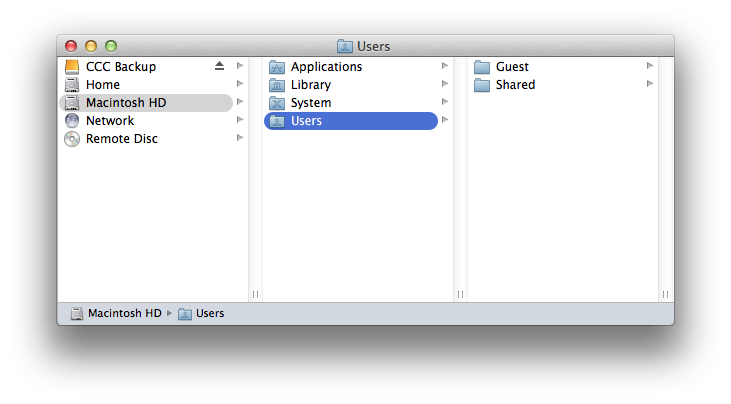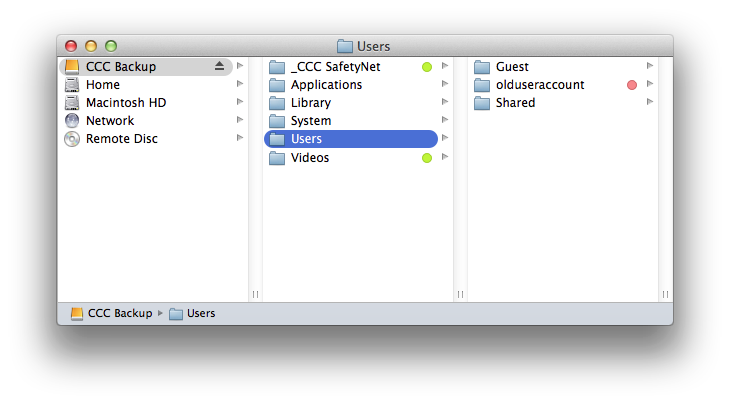In a typical backup scenario, you have a disk that is dedicated to the task of backing up your startup disk, and you expect the contents of the backup disk to match the contents of the source exactly. In many cases, though, people see lots of extra space on a big 3TB disk and can't resist using it for "overflow" items — large video files, archives of old stuff, maybe your iMovie Library. If you already have that big disk loaded with some overflow items and you're hoping to use it as a backup volume as well, you'll find that CCC's default settings are designed to give you that backup without completely destroying everything else on your backup disk in the blink of an eye.
When CCC copies files to the destination, it has to do something with files that already exist on the destination — files that are within the scope of the backup task, and items that aren't on the source at all. By default, CCC uses a feature called the SafetyNet to protect files and folders that fall into three categories:
- Older versions of files that have been modified since a previous backup task
- Files that have been deleted from the source since a previous backup task
- Files and folders that are unique to the root level of the destination
SafetyNet On
When the SafetyNet is on, CCC places the older versions of modified files, and files that have been deleted from the source since a previous backup, into the _CCC SafetyNet folder at the root of the destination. We call this a "safety net" because the alternative would be to immediately delete those items. The SafetyNet prevents catastrophes — rather than immediately deleting items from the destination, CCC saves these items on the destination as long as space allows.
That third category of files and folders is left alone on the destination when the SafetyNet is enabled. Files and folders that are unique to the root level of the destination will be left completely alone. To get a better of idea of what that means, consider the following two Finder windows:


The first window shows the contents of the startup disk, with the usual Applications, Library, System, and Users folders. The second window shows the contents of the destination volume. The "root" of the destination volume is what you see in the second pane. There are two items that are unique to the root level of the destination volume, "_CCC SafetyNet" and "Videos". If CCC were to update this volume with the SafetyNet on, both of these folders, tagged as green in the screenshot, would be left alone by CCC. The Users folder, however, is not unique to the destination — that folder is present on both the source and destination. As a result, the "olduseraccount" folder that is inside the Users folder would not be left in place, rather it would be moved to the _CCC SafetyNet folder.
Limiting the growth of the SafetyNet folder
When the SafetyNet feature is enabled for a CCC backup task, CCC will automatically prune the contents of the SafetyNet folder, by default, when the free space on the destination drops below 25GB. You can modify this pruning behavior for each task by clicking the "Use Advanced Settings" button at the bottom of the CCC window. CCC offers pruning based on size of the SafetyNet folder, age of items within the SafetyNet folder, and amount of free space on the destination. If you find that your backup tasks frequently run out of space on the destination, you can modify CCC's SafetyNet pruning limit to make more space available at the beginning of each backup task.
SafetyNet Off
If you always want the destination to match the source, and you have no need for retaining older versions of modified files or files deleted from the destination since a previous backup task, you can disable CCC's SafetyNet with the large switch icon underneath the destination selector. When CCC's SafetyNet is disabled, older versions of modified files will be deleted once the updated replacement file has been successfully copied to the destination, and files that only exist on the destination will be deleted permanently. Files and folders that are unique to the destination will not be given special protection from deletion. The only exception to this is the _CCC SafetyNet folder — CCC will not delete that folder. If the _CCC SafetyNet folder was created in a previous task that had the SafetyNet enabled, you can simply drag the SafetyNet folder to the Trash to dispose of it.
Advanced setting: Don't delete anything
When advanced settings are enabled, a third SafetyNet setting is available: Don't delete anything. With this setting, CCC won't delete anything from the destination. If a file exists on the destination and not on the source, that file will be left in place on the destination. If a file will be updated on the destination, the older version of the file will be moved to CCC's SafetyNet folder. This setting is useful for source folders and volumes that leverage excellent organization. For example, if you store photos by project name, and you like to remove those projects from the source as a whole when the project is complete, you can use the Don't delete anything SafetyNet setting to avoid removing the archived projects from the destination.
One cautionary note about using this setting: Older files will accumulate on the destination, consuming more space than is consumed on the source. Also, if your files are not well organized, you may find a future restore to be quite tedious because everything you've deleted from the source will still be on the backup.
Other ways to protect the data on your backup volume
If you would rather that CCC did not move or delete files that are unique to your backup volume (e.g. files that are not part of the source data set), there are a couple other ways to protect that data.
Add a new partition to the destination hard drive
You can use Disk Utility to resize existing volumes (those volumes must be formatted with a filesystem that supports resizing, such as HFS+) and to add new partitions. These actions can be done non-destructively, that is, without erasing the files and folders on any existing volumes.
Watch a video that demonstrates how to add a partition to your backup disk
Back up to a folder
You can use CCC to back up your data to a subfolder on the destination volume. When backing up to a subfolder on the destination volume, CCC's copying and deleting considerations are made entirely within the scope of that subfolder — content outside of that subfolder is not considered or affected by the backup task. To back up to a folder, select "Choose a folder..." from CCC's Destination selector.
General thoughts on keeping "other" data on your backup volume
We strongly recommend that you find the means to dedicate a volume to the task of backing up your irreplaceable data. If you have data on your backup volume that exists nowhere else, it is not backed up! Whenever you target a volume for use with Carbon Copy Cloner, there is a risk that some files will be removed for one legitimate reason or another. CCC offers options and warnings to protect your data from loss, but nothing can protect your data from a misuse of CCC or a misunderstanding of the functionality that it provides.